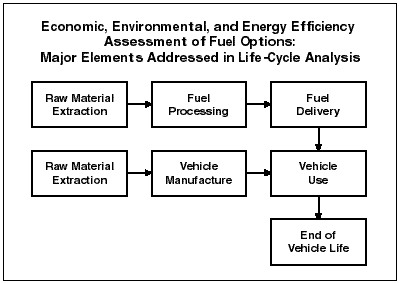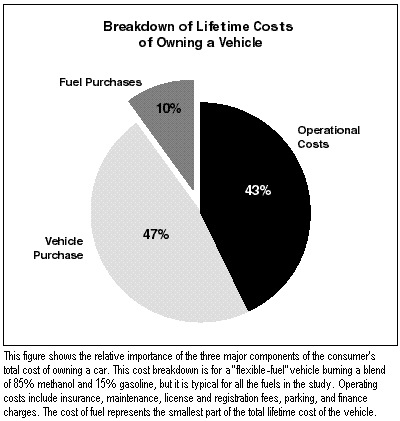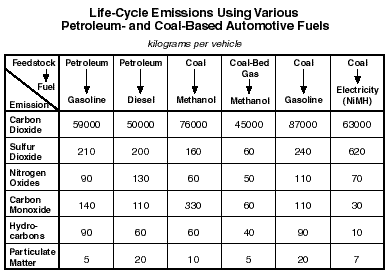
July-September 1997 Issue
Options for Using China's Coal in Cars: A Life-Cycle Assessment

July-September 1997 Issue
Options for Using China's Coal in Cars: A
Life-Cycle Assessment
![]() hinese policymakers
face a bewildering array of options as they consider using their vast coal
deposits to fuel vehicles. Coal can be used to produce gasoline, methanol,
or electricity. But each of those fuels has its advantages and disadvantages.
MIT researchers and their Chinese and American collaborators have now estimated
how shifting from petroleum to each coal-based fuel would change consumer
costs, environmental impacts, and energy efficiency. Their life-cycle analyses
included the complete history of each type of fuel and vehicle, from extraction
of raw materials through production, use, and disposal. As expected, changing
to any of the coal-based fuels would reduce efficiency, increase carbon
dioxide emissions, and cost more. However, the added cost is a relatively
small fraction of the total cost of owning a vehicle--except in the case
of electricity, which is prohibitively expensive unless batteries improve
dramatically. Effects on emissions other than carbon dioxide vary from
fuel to fuel. This type of comprehensive assessment represents a methodology
that can also be used to compare technology options in other fields.
hinese policymakers
face a bewildering array of options as they consider using their vast coal
deposits to fuel vehicles. Coal can be used to produce gasoline, methanol,
or electricity. But each of those fuels has its advantages and disadvantages.
MIT researchers and their Chinese and American collaborators have now estimated
how shifting from petroleum to each coal-based fuel would change consumer
costs, environmental impacts, and energy efficiency. Their life-cycle analyses
included the complete history of each type of fuel and vehicle, from extraction
of raw materials through production, use, and disposal. As expected, changing
to any of the coal-based fuels would reduce efficiency, increase carbon
dioxide emissions, and cost more. However, the added cost is a relatively
small fraction of the total cost of owning a vehicle--except in the case
of electricity, which is prohibitively expensive unless batteries improve
dramatically. Effects on emissions other than carbon dioxide vary from
fuel to fuel. This type of comprehensive assessment represents a methodology
that can also be used to compare technology options in other fields.
China is the world's largest coal producer. Yet in recent
years this coal-rich nation has had to import petroleum, largely to fuel
its rapidly growing transportation sector. Concerned about energy security,
Chinese policymakers are now considering ways to use coal in place of petroleum,
particularly as an automotive fuel. Processes exist for converting coal
into gasoline, methanol, and electricity, any of which can run a car. The
challenge is to identify the option that best meets the policymakers' three
main goals: to minimize costs to the consumer, to minimize environmental
damage, and to use the nation's domestic resources most efficiently. Unfortunately,
no single option is the obvious winner on all fronts.
In 1996, the Chinese government initiated a study to clarify and evaluate
the costs and benefits associated with the various options. Collaborating
in the study were more than forty technical experts from MIT, Ford Motor
Company, Tsinghua University, and several agencies of the government of
the Peoples Republic of China. MIT's part of the work was coordinated by
the Energy Laboratory and led by Malcolm A. Weiss, senior research staff
member at the Laboratory. The Ford team was led by Walter M. Kreucher,
manager, Advanced Environmental and Fuels Engineering, and the Chinese
team by Qiming Zhu, professor at Tsinghua University.
The goal of the study was not to make specific recommendations but to provide
Chinese leaders with sound scientific information on the potential consequences
of different approaches to using coal as an automotive fuel. The approach
ultimately adopted by Chinese policymakers will, of course, take into account
other societal concerns not examined in the study.
Switching from petroleum-derived gasoline to a coal-based fuel is not a simple matter. It may affect the entire history of the fuel, the car, and their use together. Therefore, the researchers performed their assessment using a technique known as life-cycle analysis. The schematic below shows the elements considered in the analysis. The top boxes follow the fate of the fuel-extraction from the ground, processing into a form useful in an automobile (including electricity), and delivery to the vehicle. The bottom boxes trace the vehicle's history, including extraction of the raw materials and manufacture of a vehicle suited to the fuel being assessed. The last two boxes represent the use of the fuel in the car and the disposal of the car at the end of its useful life.

To perform a life-cycle analysis of a given fuel "scenario,"
the researchers had to determine the economic cost, energy efficiency,
and environmental impacts of each of those steps (each box in the diagram).
But it is not possible to produce absolute quantitative values for all
scenarios that everyone will agree on. Consider just one variable: the
cost of manufacturing cars that run on methanol rather than on gasoline.
Two automotive experts are unlikely to agree on the exact cost of making
a gasoline car, much less the more unfamiliar methanol car. Debate will
arise about even broad assumptions. (Will the cars be made in China? Will
the engines be imported from Japan?) But experts can agree on roughly how
much it costs to manufacture a gasoline car. Moreover, they can agree on
generally what changes are needed to make a methanol car instead. And they
can calculate how much those changes will cost or save.
The researchers therefore performed their assessment as a comparative analysis.
They assumed as their base case a Ford Escort fueled by petroleum-derived
gasoline, equipped with an emission-control catalyst, and operated for
12 years. (Catalysts are not used in China now because unleaded gasoline
is not generally available. Both are expected to come into widespread use
by the year 2000.) They then estimated the performance measures of interest:
the cost to the consumer, the environmental impacts, and the energy efficiency
associated with each step in the diagram. For each coal-based scenario
they determined how each of those three measures would change from the
base case, first within each step and then cumulatively. They thus ranked
the options relative to the base case and relative to one another on each
of the performance measures.
The analysis focused on fuel options of particular interest to the Chinese
participants. It considered two petroleum-based fuels--gasoline (the base
case) and diesel--and three coal-based fuels--gasoline, electricity, and
methanol. For each coal-based option, they made certain assumptions.
All the data used in the study are intended to reflect
conditions in China, which often differ from corresponding conditions in
the United States. Chinese participants in the study provided data on costs,
air emissions, and energy efficiency for each fuel scenario. Ford developed
data for vehicle manufacturing and operation. The analyses were performed
using a variety of existing spreadsheet-based models and computer simulations,
specially tailored for this life-cycle analysis.
Chinese policymakers are concerned about energy efficiency not only because
they do not want to waste resources but also--perhaps more importantly--because
energy efficiency can affect both economic cost and environmental impacts.
The most direct effect of energy efficiency is on emissions of carbon dioxide
(CO2): the more efficient a fuel scenario,
the lower its emissions of CO2.
To determine the energy efficiency of each fuel scenario, the analysis
tracked energy input versus energy output in each step of the life-cycle
diagram. Converting coal to automotive fuels is inefficient, so the lifetime
energy efficiencies of all the coal-based scenarios are lower than those
of the petroleum scenarios (both gasoline and diesel). Electricity does
best of the coal-based scenarios because of the higher efficiency of operating
electric vehicles. But that advantage is offset by the inefficiency of
generating electricity from coal.
In contrast to energy efficiency, cost plays a direct and important role
in deciding the attractiveness of the options. The analysis focused on
cost to the consumer. What would switching to coal mean for the owner's
out-of-pocket expenses during the lifetime of the vehicle? The expenses
included no government-imposed taxes or fees, and costs incurred in different
years were not discounted.
A consumer's total cost consists of three components: buying the car, buying
fuel, and operating the car. (Operating costs include insurance, maintenance,
license and registration fees, parking, and finance charges on car loans.)
The table below shows how each of those components differs from the base case
for each scenario, yielding a life-cycle cost differential to the consumer.

As shown in the table, the consumer's expenditure on fuel
varies dramatically from scenario to scenario. However, the cost of buying
fuel is a small part of the total lifetime cost associated with having
a car. As shown in the pie chart below, buying fuel is only about 10% of
the total cost, with the remainder split about equally between buying the
car and operating it.

The total incremental costs for the non-electricity coal-based
scenarios do not differ greatly--from one another or from the gasoline
base case. The distributions of costs among the three components differ,
but the bottom line is about the same: having a (non-electric) coal-fueled
car costs $2000-3000 more than having a conventional petroleum-fueled car.
That added cost, spread over the 12-year lifetime of the car, is relatively
small: the total cost of a conventional petroleum vehicle is estimated
at $40,000, so the variation is only about 5%.
The outcome is quite different with the electric option. Assuming an electric
car with an NiMH battery, the consumer pays $700 less for fuel than in
the base case. But that saving is offset by dramatically higher costs to
buy and operate the vehicle. Overall, the consumer will pay close to $15,000
more to own and drive an electric car--a substantial increase, even spread
over 12 years. And despite the high cost, the consumer will still get a
car with the power and range limitations that make electric vehicles unmarketable
today. Analyses of the other battery options show that the cost of switching
to electricity is comparable to that of the other coal-based options only
if batteries meet the Battery Consortium's long-term goals for cost and
storage capacity.
Comparing the environmental effects of the different scenarios is more
complex. Again, the analysis looked at emissions during the processing
of the fuel and the manufacturing of the vehicle as well as "on-road"
vehicle emissions, based on a standard urban driving cycle defined by the
US Environmental Protection Agency. The table below presents detailed results
for key pollutants. (The values are absolute rather than comparative to
show which emission levels and changes are large enough to be of concern.)

A few generalizations can be made. Coal-bed gas is the winner
in most areas--not a surprise, as starting with methane gas is always cleaner
than starting with either coal or oil. As already stated, all of the coal-based
options generate more CO2 than the petroleum-based
options do. Thus, the switch from petroleum to any of the coal-based fuels
would further increase China's already substantial contribution to greenhouse
gas emissions.
As for the other emissions (most of whose impacts are regional or local),
the outcome varies from pollutant to pollutant, with no one scenario being
the across-the-board winner. For example, methanol from coal generates
lower sulfur dioxide and nitrogen oxides emissions than do the petroleum-to-gasoline
base case and the coal-based options, but it produces lots of carbon monoxide.
Electric power beats all the other options (coal and petroleum alike) on
carbon monoxide and hydrocarbons, but it generates the most sulfur dioxide.
Petroleum-based diesel does well in most categories but has high emissions
of nitrogen oxides and particulate matter. Only gasoline from coal is relatively
straightforward: it is among the worst on almost all emissions. With its
high cost and high CO2 emissions, it ranks
low in the overall assessment.
The researchers did not expect to find a best option. They intended only
to quantify the trade-offs for the Chinese policymakers. They do, however,
emphasize that the findings depend on many assumptions. For example, if
the cost of oil was higher than they assumed or if the cost of manufacturing
vehicles for the coal-based fuels was lower, the economic viability of
all the coal-based options would improve. They also caution that other
factors must be examined. For example, for each scenario they estimated
water requirements but not whether those requirements could be met. Land
use has yet to be addressed, and a detailed examination of the technical
feasibility of each option is needed. Nevertheless, the results thus far
should provide a useful foundation for Chinese policymaking.
Another important contribution is the analytical methodology itself. The
computer models developed are simple, flexible, and transparent so that
users can easily make clear and consistent comparisons of the impacts of
different technology options and can readily see the results of changing
underlying assumptions such as the cost of oil. This type of life-cycle
analysis can also be used in other areas in which the technology options
are many, their impacts are uncertain, and their costs and benefits are
variable.
This research at MIT was supported by the Ford Motor Company. Further information can be found in references.